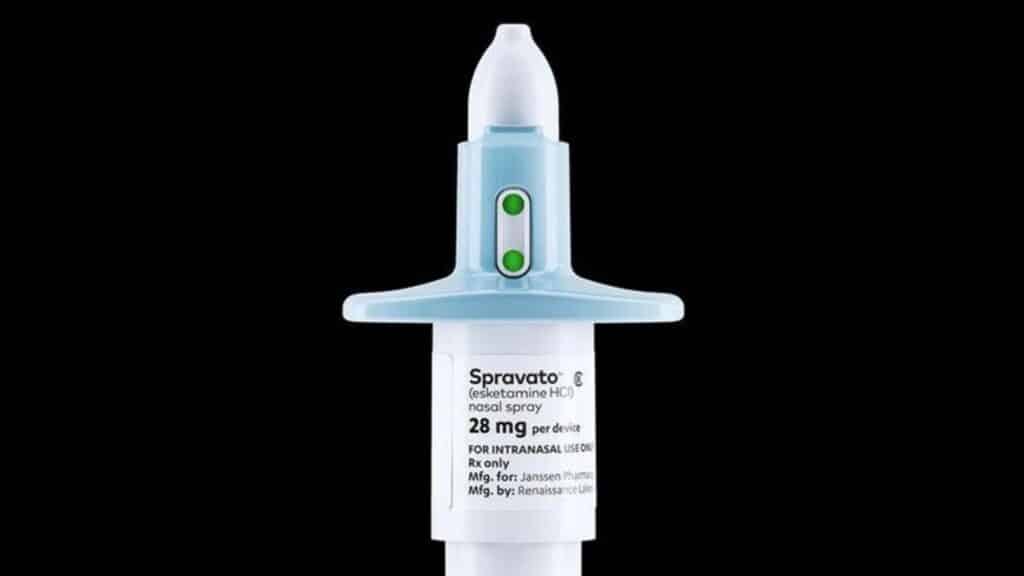Intranasal Ketamine for Depression: A Powerful and Cutting-Edge Treatment Option
Call: (475) 329 2686The Sterling Institute is a facility in Danbury, Connecticut that offers intranasal ketamine therapy treatment for depression. Depression, or major depressive disorder (MDD), is a prevalent and debilitating mental health condition, and the Sterling Institute provides alternative options for individuals struggling with treatment-resistant depression, meaning they have not responded to traditional treatments.

How Does Intranasal Ketamine Work?
Ketamine is a very safe and effective medication developed during the Vietnam War for use on the battlefield as an anesthetic. It is still used today for that purpose, for example in pediatric dentistry because it goes in and out of the body so quickly. Intranasal ketamine is a novel method of delivering ketamine for the treatment of depression. It involves the administration of ketamine via a nasal spray, which allows for rapid absorption into the bloodstream through the nasal mucosa. A single nasal spray of ketamine typically contains a low dose of racemic arketamine and esketamine, ranging from 5mg to 20mg, at 20mg depending on the protocol used.
According to Dr. Satinover, the lead psychiatrist at Sterling Institute, “Ketamine was developed in the 1960s as a rapid-on, rapid-off field-hospital anesthetic for combat injuries. Medics treating soldiers on active battlefields discovered that it could be administered in the mud, so to speak, as a nasal spray, where IV insertion was impractical and too slow. This improvisation was only rediscovered decades later. It works because nasal absorption of ketamine is a very high 50%.”
Understanding Intranasal Ketamine for Depression
The exact mechanism of action of ketamine in treating depression is not fully understood. However, it is believed to work by blocking the N-methyl-D-aspartate (NMDA) receptor, which leads to increased production of the neurotransmitter glutamate. This, in turn, stimulates the production of new synaptic connections in the brain, leading to improved mood and cognitive function.
Dr. Satinover explains, “The presumptive antidepressant effect of ketamine is blockade of the NMDA-type glutamate receptor. Glutamate is another neurotransmitter chemical alongside the more familiar serotonin, norepinephrine and dopamine, but more foundational to brain regulation mechanisms than these.”
Our brain has many different chemicals called neurotransmitters that are responsible for regulating different functions in our body and mind. You may have heard of some of them like serotonin, dopamine, and norepinephrine which play a crucial role in regulating our mood, emotions, and behaviors. One such neurotransmitter is called glutamate and it plays a foundational role in regulating the brain’s functions.
When we feel sad, it’s because there is an imbalance in the levels of these neurotransmitters, and our brain needs to reset itself to restore this balance. Ketamine is a medication that helps to restore this balance by blocking a specific type of receptor called the NMDA-type glutamate receptor. By blocking these receptors, ketamine allows other neurotransmitters like serotonin, norepinephrine, and dopamine to work more efficiently, which can improve our mood and relieve symptoms of depression.
Effectiveness of Intranasal Ketamine for Depression
Several clinical trials have investigated the effectiveness of intranasal ketamine for the treatment of depression. A systematic review and meta-analysis of these studies found that intranasal ketamine was significantly more effective than a placebo in reducing symptoms of depression. The response rates ranged from 53% to 82%, depending on the study protocol and dosage used.
For patients that wish to feel relief from depression faster, intranasal ketamine is an excellent choice. Studies have shown that intranasal ketamine has a rapid onset of action, with many patients experiencing relief of symptoms within hours of treatment.
How Intranasal Ketamine Provides Rapid Relief for Depression
The effects of intranasal ketamine for depression can last for several days to weeks, which is longer than the effects of traditional antidepressant medications. This prolonged duration of effect may be due to the fact that ketamine has a unique mechanism of action compared to traditional antidepressants, which primarily target the monoamine neurotransmitter systems.
The monoamine neurotransmitter systems, which include serotonin, norepinephrine, and dopamine, have been the primary target of traditional antidepressant medications for decades. These neurotransmitters are involved in regulating mood, emotions, and behavior, and imbalances in these systems have been implicated in the development of depression.
Traditional antidepressant medications work by increasing the availability of these neurotransmitters in the brain, either by blocking their reuptake or by inhibiting their metabolism. By doing so, these medications aim to restore balance to the monoamine neurotransmitter systems, which can improve symptoms of depression.
However, these traditional medications can take several weeks to take effect, and many patients do not respond adequately or at all to these treatments. This has led researchers to investigate new treatment options that target different neurotransmitter systems.Ketamine, on the other hand, leads to increased availability of another neurotransmitter called glutamate by blocking NMDA receptors in the brain. Glutamate is known to play a key role in the regulation of synaptic plasticity, which is the brain’s ability to adapt and change in response to experience. This is thought to be one of the reasons why ketamine has a more rapid onset of action compared to traditional antidepressants.
Safety & Side Effects of Intranasal Ketamine
Intranasal ketamine is generally considered safe when used under the supervision of a trained healthcare professional, such as the skilled professionals at Sterling Institute. However, it can cause some side effects, such as dizziness, nausea, headache, increased heart rate, elevated blood pressure, disorientation, and fatigue.
These side effects are usually mild and short-lived, lasting only a few hours after administration. However, in rare cases, intranasal ketamine can cause more severe side effects, such as hallucinations, delusions, and dissociative experiences.
It is important to be aware of the potential side effects of ketamine and to report any adverse reactions to your healthcare provider immediately.
How We Use Intranasal Ketamine for Depression at Sterling Institute in Connecticut
Sterling Institute is a leading provider of intranasal ketamine treatment for depression in Connecticut. We offer a compassionate and personalized approach to care, with a team of trained healthcare professionals who specialize in the use of ketamine for depression.
Our team of experts includes psychiatrists and nurse practitioners who work collaboratively to provide patients with the highest quality of care. We have extensive experience in the use of ketamine for depression and are committed to helping patients achieve optimal outcomes.
The Sterling Institute’s approach to treatment is tailored to each patient’s individual needs and response to treatment. The dose and frequency of administration are determined by the patient’s symptoms and medical history. This personalized approach helps to ensure that patients receive the right dose of ketamine at the right time for maximum benefit.
We also provide comprehensive follow-up care to monitor patients’ progress and adjust treatment plans as needed.
In addition to intranasal ketamine treatment, the Sterling Institute offers a range of other services to help patients struggling with depression, including psychotherapy, medication management, and lifestyle interventions. This comprehensive approach to care is designed to address the underlying causes of depression and help patients achieve long-term wellness.
Frequently Asked Questions (FAQs)
Is intranasal ketamine covered by insurance?
At the Sterling Institute, intranasal ketamine is not covered by insurance. However, recent advancements in the field, including FDA approval, have dramatically reduced the cost of this procedure.
Can intranasal ketamine be used with other medications?
Intranasal ketamine should be used with caution in individuals taking other medications that affect brain chemistry. This is why our team conducts a thorough evaluation for all clients to make sure that intranasal ketamine is an appropriate option for you.
How often should intranasal ketamine be administered?
The frequency of intranasal ketamine administration depends on the individual’s needs and response to treatment.
Are there any long-term risks associated with intranasal ketamine use?
FDA-approved labeling for ketamine contains warnings and precautions on hemodynamic instability, emergence reactions (vivid dreams, hallucinations, or delirium), respiratory depression. The effects of long-term use of dissociative drugs have not been exhaustively studied though, which is why our team closely monitors all our patients to make sure it continues to be an effective treatment option.
What other conditions do you treat at Sterling Institute?
Sterling specializes in addressing a broad range of mental health challenges, including depression, anxiety disorders, ADHD, OCD, bipolar disorder, mood disorders, eating disorders, impulse control disorders, post-traumatic stress disorder (PTSD), and issues related to grief and loss.
What areas of Connecticut does Sterling Institute service?
Sterling Institute is renowned for its mental health services across Connecticut and other states, frequently assisting residents in areas like Bedford, Manchester, Milford, New Haven, West Hartford, and Stamford, among others.
Overcome Depression with Intranasal Ketamine Therapy at Sterling Institute in Connecticut
Intranasal ketamine has emerged as a promising and innovative treatment option for individuals suffering from depression, particularly for those who have not responded to traditional treatments. The Sterling Institute in Connecticut is at the forefront of providing this cutting-edge therapy.
The rapid onset of action and potential for long-lasting relief from depressive symptoms make intranasal ketamine an attractive option for many patients. By offering a comprehensive range of psychiatry services, including intranasal ketamine, psychotherapy, medication management, and lifestyle interventions, the Sterling Institute aims to address the underlying causes of depression and support patients on their journey towards long-term wellness.
As our understanding of ketamine’s role in treating depression continues to grow, intranasal ketamine therapy at Sterling Institute offers hope for a brighter future for those struggling with this debilitating mental health condition.

